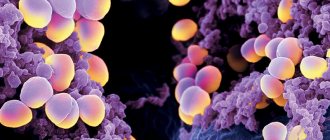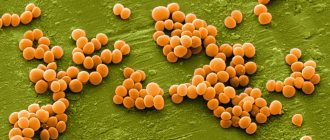Staphylococci are bacteria that cause infection in children of all ages. Despite the fairly wide spread of the disease, it frightens many parents in our time. The reason for this fear is quite simple: people are poorly informed about what this infectious disease truly is.
Staphylococcus poses a serious danger only in certain cases. Everything directly depends on what type of bacteria the baby is infected with, as well as on how effective the child’s immune system is. What are the symptoms of staphylococcus in a child’s stool?
Causes of childhood staphylococcus disease
Staphylococcal infection is life-threatening for a child
Staphylococcal infection is a disease caused by bacteria of the same name. As with many infectious diseases, there are several reasons for a child to become infected. Staphylococcus comes in various types, among which it is customary to distinguish:
- saprophytic staphylococcus. The least common type of infection among children. Affects the genitourinary system. It poses a low risk to humans and, with proper treatment, can be cured within a few days.
- epidermal staphylococcus. This species often affects babies who have undergone surgery or have weakened immune systems. It is not dangerous for healthy children, and in case of skin lesions, local therapy is most often prescribed.
- Staphylococcus aureus. The most dangerous type of bacteria. It received this name because of the characteristic color of the colonies that microorganisms form. It affects the gastrointestinal tract and is often observed in the mucous membrane and on the surface of the skin.
One of the main reasons for infection of children with staphylococcus is considered to be weakened immunity. The good, effective functioning of the child’s body’s defense system is remarkably resistant to various pathogenic microorganisms, the danger of infection from which is encountered literally at every step. In some cases, the tests show the presence of bacteria in the body, but no infection is observed: this is explained by the successful protective function of a healthy baby.
But a child whose immunity is weakened is poorly protected from the negative effects of bacteria and therefore can get sick. However, the modern level of medicine makes it possible to avoid the negative consequences of staphylococcal infection if therapy is started on time.
Staphylococcus in a child's stool is a cause for concern
The second most common cause of infection of a child with staphylococcus is considered to be a banal failure to comply with hygiene rules. Pathogenic microorganisms live in dirty places, and since young children are often not accustomed to washing their hands before eating and like to put everything they can get their hands on in their mouths, they increase the risk of staphylococcus infection.
Another option for the spread of staphylococcal infection is direct infection of a child from an already infected person. Infection can occur through damaged skin or through the mucous membrane. When the carriers of the disease are catering workers or hospital employees, the baby can become infected through food in kindergarten or school, or after being in the hospital where he was subjected to certain procedures.
The disease can be spread by insects, so their bite sites should always be treated.
Staphylococcus is an infectious disease caused by staphylococcus bacteria. There are several types that affect different body systems, have different levels of danger and also respond differently to treatment. The main reason for the development of staphylococcal infection in a child is his low level of immunity.
Staphyloderma of newborns
Vesiculopustulosis
Vesiculopustulosis (ostioporitis, periporitis) is a superficial form of staphyloderma of newborns, developing as a result of acute purulent inflammation of the orifices of the sweat glands.
This is the most common form of neonatal staphyloderma (33% of all cases), usually developing in a child on days 3-5 of life. As a rule, the causative agent of vesiculopustulosis is Staphylococcus epidermidis or Staphylococcus aureus, less often other strains. Skin symptoms with vesiculopustulosis are represented by the appearance of white-yellow follicular pustules surrounded by a hyperemic corolla, the size of millet grains. Pustules are most often located in the axillary and inguinal folds, on the chest and neck, on the back and buttocks, in the scalp, although they can merge and spread to large areas of the skin. The pustules dry out quite quickly into crusts, after which no traces remain after being rejected.
In weakened newborns, this form of staphyloderma may be accompanied by low-grade fever and complications - otitis media, bronchopneumonia, pyelonephritis. Differential diagnosis of vesiculopustulosis is carried out with scabies.
Finger's pseudofurunculosis
Finger's pseudofurunculosis or multiple skin abscesses are characterized by purulent inflammation of the eccrine sweat glands and in 70% of cases are combined with vesiculopustulosis.
With pseudofurunculosis, numerous dense inflammatory nodules the size of a pea appear in the back of the neck, back, thighs and buttocks. The skin over them takes on a bluish-red hue. The nodes gradually increase to the size of a cherry, and when they reach the stage of abscesses, they open with the release of liquid, purulent-bloody contents. This form of staphyloderma in newborns lasts a long time, with disturbances in the general condition of the child (temperature reaction, weakness, etc.). In place of long-term non-healing ulcers, scars form.
With Finger's pseudofurunculosis, differential diagnosis is required with furunculosis, hidradenitis, colliquative tuberculosis of the skin (scrofuloderma).
Epidemic pemphigus of newborns
Being a type of staphyloderma, epidemic pemphigus or neonatal pemphigoid affects children aged 3-10 days. The disease is highly contagious, has generalized damage to the skin and mucous membranes, and has systemic manifestations.
The onset of epidemic pemphigus in newborns is characterized by the appearance of a disseminated rash on the skin of the trunk, limbs, and in large folds. The rash is polymorphic, with a typical evolution of elements from blisters to phlyctene pustules, then to erosions and serous-purulent crusts. Elements of the rash often spread to the mucous membranes of the nose, mouth, eyes, and genitals. This form of staphyloderma of newborns in children with an unfavorable perinatal history and asthenia occurs with a rise in body temperature, diarrhea, and decreased appetite; in severe cases, neonatal sepsis may develop.
When conducting diagnostics, syphilitic pemphigus of newborns, chickenpox, and epidermolysis bullosa should be excluded.
Exfoliative dermatitis of newborns
Ritter's disease, exfoliative dermatitis or scalded skin syndrome, is one of the most severe forms of epidemic pemphigus of newborns. With this form of staphyloderma, skin damage is diffuse and occurs with the formation of large superficial blisters, reminiscent of a second-degree skin burn. It is caused by Staphylococcus aureus of phage group II, phage type 71, which, due to the release of the exotoxin epidermolysin, causes acantholysis (loss of intercellular connections between epidermocytes).
In its development, exfoliative dermatitis of newborns goes through 3 stages: erythematous, exfoliative and regenerative. Staphyloderma begins with the appearance of erythema of the skin in the mouth, navel, genitals or anus. After 1-2 days, redness of the skin spreads throughout the body; large multiple blisters appear, which open with the formation of extensive weeping erosive surfaces. In the septic course of exfoliative dermatitis, fever, toxicosis, diarrhea, malnutrition, anemia, and dysproteinemia are associated.
Routes of infection for infants
Infection occurs in three main ways:
- contact between sick mother and child;
- breast-feeding;
- directly during childbirth.
There is also a high probability of a child becoming infected if personal hygiene rules are not followed.
Since a child constantly puts everything around him into his mouth, he is susceptible to infection. Therefore, parents should monitor his hygiene.
Infection can occur from infected medical personnel. This occurs if the health worker was not diagnosed with a disease in a timely manner or if he did not sufficiently carry out hygiene measures before the procedures. This is how staphylococcus gets to the newborn from the environment.
Airborne infection is also possible. It provokes the following pathological conditions:
- rhinitis;
- sore throat;
- pharyngitis.
Infection is possible due to non-compliance with hygiene standards when treating the umbilical wound.
It should also be taken into account that staphylococcus is present in some quantity in the body of every person, including infants. It usually occurs when the immune system is weakened.
The development of infection can be triggered by:
- pathological pregnancy, childbirth;
- malnutrition of the baby;
- prematurity.
The infection develops in children who often suffer from acute respiratory viral infections and suffer from dysbacteriosis. In such children, the body's protective functions are significantly weakened, so they are extremely susceptible to infection by any pathogenic bacteria.
Staphylococcus: what to expect and what to do?
Staphylococci are widespread in nature.
They are everywhere.
In water, soil, on the skin and mucous membranes of people and animals. But pathogenic, i.e. Staphylococcus aureus (Staphylococcus aureus) and, to a lesser extent, staphylococcus epidermidis (Staphylococcus epidermidis) may be potentially dangerous. These microbes are classified as opportunistic microorganisms, i.e. they can cause disease only under certain conditions, and generally live quietly on human mucous membranes and skin without causing harm.
In humans, Staphylococcus aureus lives in the intestines, vestibule of the nose, perineum, armpits, and navel. They are found in the vestibule of the nose in 40-50% of healthy adults, in the intestines in 60-70% of healthy people.
Staphylococcus epidermidis is considered non-pathogenic, but in patients with immunodeficiency, prosthetic heart valves, and vascular catheters, they can cause nosocomial infections.
The pathogen can be transmitted from a patient or carrier by airborne droplets, contact, and fecal-oral routes.
The list of diseases caused by staphylococci is very long.
These are infections of the skin and subcutaneous tissue (styes, boils, carbuncles, skin abscesses, imetigo, phlegmon).
Staphylococci are involved in a variety of infections of the ENT organs (sinusitis, tonsillitis, adenoiditis, otitis), and also cause bronchitis and pneumonia.
It is dangerous if infection occurs in a hospital, because nosocomial staphylococci are resistant to many antibiotics and treating such an infection becomes very problematic.
Sometimes, especially in young children, staphylococcal intestinal infections and enterocolitis occur. In adults, foodborne toxic infections more often occur, when the disease is caused not by staphylococcus itself, but by its toxins accumulated in a poor-quality product that has been infected with staphylococci.
If a virulent (highly contagious) strain of staphylococcus appears in a maternity hospital or maternity ward, the infection can spread quickly. More often, the infection in newborns is mild, manifesting mainly as pustules around the nail folds, and occasionally deeper tissues are affected.
In newborns, some strains of staph can cause a severe skin infection called scalded skin syndrome (Ritter's disease). Women who feed a sick child may develop staphylococcal purulent mastitis.
Staphylococcus is also involved in such a serious disease as osteomyelitis (inflammation of the bones and bone marrow). Staphylococci most often enter the bone from foci in the skin or nasopharynx, but sometimes the entrance gates of the infection remain undetected.
If staphylococci penetrate the so-called blood-brain barrier, a terrible disease develops - meningoencephalitis.
Also, with severe immunodeficiency, staphylococcal sepsis can develop. In this case, staphylococcus penetrates into the bloodstream from any source of infection on the skin or subcutaneous tissue.
However, the above severe diseases rarely occur, because in most cases the protective barriers are triggered, and the infection is either limited to local forms and easily treated, or does not develop at all. But it can remain as a carrier, which does not prevent a person from feeling absolutely healthy.
If tests reveal staphylococcus, this does not mean that it needs to be treated.
We should treat only the disease, not tests. And if a person has no complaints, then there is no need to worry in vain.
Workers of certain professions, enterprises and organizations (food industry, maternity hospitals, surgical departments, etc.) are subject to periodic examination and testing for staphylococci. And so, if pathogens are identified, they undergo preventive sanitation of possible foci of infection so that their carriage of staphylococcus does not become a risk factor for others.
Be healthy!
about the author
- Dobrelya Ekaterina Alexandrovna
- Pediatrician, infectious disease specialist of the highest category
- All publications by the author
Symptoms and signs of staphylococcus in infants
Symptoms of staphylococcus may vary, depending on the location of the parasite:
| Damage to the dermis | Large purulent formations appear on the skin, which burst and the infection spreads to healthy areas. This condition is highly contagious and can be fatal. |
| Damage to the nasopharynx and respiratory tract | It is quite difficult and is accompanied by:
In severe cases, pulmonary edema and emphysema develop. |
| Eye area |
This pathology can lead to partial or complete loss of vision. |
| Gastrointestinal tract |
|
| Circulatory system |
|
Symptoms may be similar to the course of other diseases, so if negative signs appear, it is better to contact a medical institution to make an accurate diagnosis and select adequate treatment methods.
Treatment of the disease
Staphylococcal infections are difficult to treat, especially in children. The earlier the disease is detected, the greater the likelihood that the child will soon become healthy.
Therapy includes the following activities:
- Local treatment. This is the treatment of rashes and pustules.
- Antibiotics. Staphylococcus is very adaptable and difficult to treat with antibiotics. However, penicillin drugs are often prescribed.
- Lubricating, rinsing - this treatment is effective for staphylococcus in the nose and throat.
- Vitamin and mineral complexes.
- Immunomodulators.
- Blood or plasma transfusions. Prescribed in severe cases, with sepsis.
- Operation. In cases of severe chronic tonsillitis, the tonsils are removed. The operation is also prescribed for multiple skin lesions with profuse inflammation and exudate.
Komarovsky about staphylococcus in infants
Both adults and children experience staphylococcal infections. The bacterium can provoke various diseases, leading to serious consequences and death. The bacterium easily penetrates any organ or system of the body, regardless of the person’s age.
Komarovsky believes that the fight against this microorganism is the most difficult process of our time. Staphylococcus in infants extremely quickly develops resistance to antibiotics, which significantly complicates the treatment process.
Sooner or later, the latest medicine becomes ineffective in combating the bacterium.
But the resistance of the bacterium is not its most dangerous aspect. After an illness, the human immune system does not develop protection against staphylococcus, so the risk of relapse is extremely high.
However, detection of infection in tests does not mean that treatment should be started immediately. Komarovsky argues that therapy is necessary only in cases where the microorganism has begun to manifest itself in a negative way.
Symptoms of infection
Symptoms vary widely depending on the affected organ, the patient’s immunity, and his age. There are cases of asymptomatic bacteremia, when microorganisms are found in the blood, but do not cause concern and do not affect the functioning of organs.
However, the most common symptoms may include:
- formation of pustules and carbuncles on the skin;
- stomatitis, conjunctivitis and other local inflammations;
- the appearance of skin rashes accompanied by itching;
- increased body temperature, fever;
- loss of appetite, general weakness and apathy;
- problems with the gastrointestinal tract: nausea, vomiting, flatulence, diarrhea;
- Redness of the throat and enlarged tonsils are symptoms of tonsillitis.
Since staphylococci can affect any organ, symptoms may also vary.
Diagnosis and degree of infection
To detect staphylococcus in an infant, it is necessary to conduct a bacterial culture. Most of the symptoms of inflammatory pathologies are quite similar to each other, therefore, to make an accurate diagnosis, the most reliable diagnostic methods are necessary.
Indications for tests are:
- elevated temperature;
- loss of appetite;
- sleep disorders;
- problems with stool;
- restless behavior;
- sore throat, pneumonia, conjunctivitis.
For treatment, the baby and his mother are isolated in the inpatient department. The normal indicator in the test results is the presence of staphylococcus in the 4th degree, the ideal is its absence.










